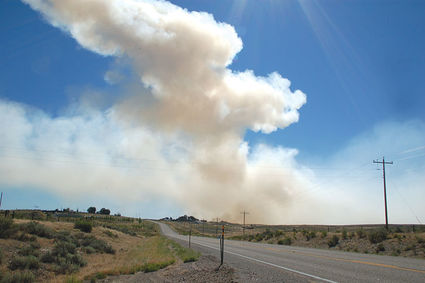Burning barley fields to be addressed this fall

Karla Pomeroy
Barley producers around Worland have been burning fields over the past few weeks, causing one reident to bring health concerns to the Washakie County commissioners.
WORLAND - With the end of barley harvest upon the Big Horn Basin, farmers are in the process of burning their fields in preparation of planting for next season.
One Worland resident is concerned with the health effects of burning fields. Bill Williamson told the Northern Wyoming Daily News that he is experiencing negative health effects which he believes is due to burning barley fields.
"Everybody complains every year.
"It affects me. It gets hard to breathe. You get up in the morning and your eyes are burning and scratchy. I think it affects everybody ... truth be known," Williamson said.
"I applaud the guys who don't. There are a lot of them (farmers) who are tilling them in. I talked to a farmer and he said he'll keep doing it (burning fields) until they change the law," Williamson said.
Williamson said he comes from a farming family that never burned fields. He approached the Washakie County commissioners Aug. 4 regarding the issue.
Washakie County Commissioner Terry Wolf called said the problem is an "ongoing issue."
"It's been an issue since I've been a commissioner," Wolf said.
Wolf continued, "It was the perfect storm for all of the smoke to lay down (in the basin)," Wolf said, referencing the smoke that was already in the air from forest fires in the region.
Wolf said he met with officials from the Wyoming Department of Environmental Quality and local farmers Monday to discuss a solution to the problem.
"After beet harvest is over with, and the farmers have wrapped up farming season, the same group will get together to review the current burning guidelines we have to see what will help aid during next year's farming season.
"The farmers had some bullet points put together to help educate the public on the needs and why they do burn," Wolf said, adding, "We do want to take into account everybody who doesn't burn."
According to Wyoming Department of Environmental Quality regulations, the maximum amount of a field a farmer can burn during a day is 130 acres.
According to Greg Meeker, District 4 engineer of the Wyoming DEQ Air Quality Division, The problem is that several farmers in the region burned their fields concurrently, creating high volumes of smoke.
The DEQ placed an air quality monitor in Worland near Newell Sargent Park this year. Meeker said that the air is monitored on a 24-hour average. While the data is still preliminary, Meeker said the air quality has been compliant on a 24-hour average.
For now, Wolf said, the issue comes down to farmers being courteous to people who live in town and who don't farm.
"Just be courteous. If you're burning a field upwind from town, wait a day or two for conditions to change."
Why burn
According to a study released by the University of Louisiana, farmers burn grain crops due to changes in harvesting technology. Today's combines harvest grain with "straw choppers" which chop and shred straw into much smaller pieces than straw throwers.
"Producers have tried repeatedly to establish stands using conventional methods without burning, but it is generally difficult," according to the study.
The practice is becoming less popular as urban sprawl continues into more traditional rural areas. However, complete elimination of straw is not possible without burning, according to the study.




